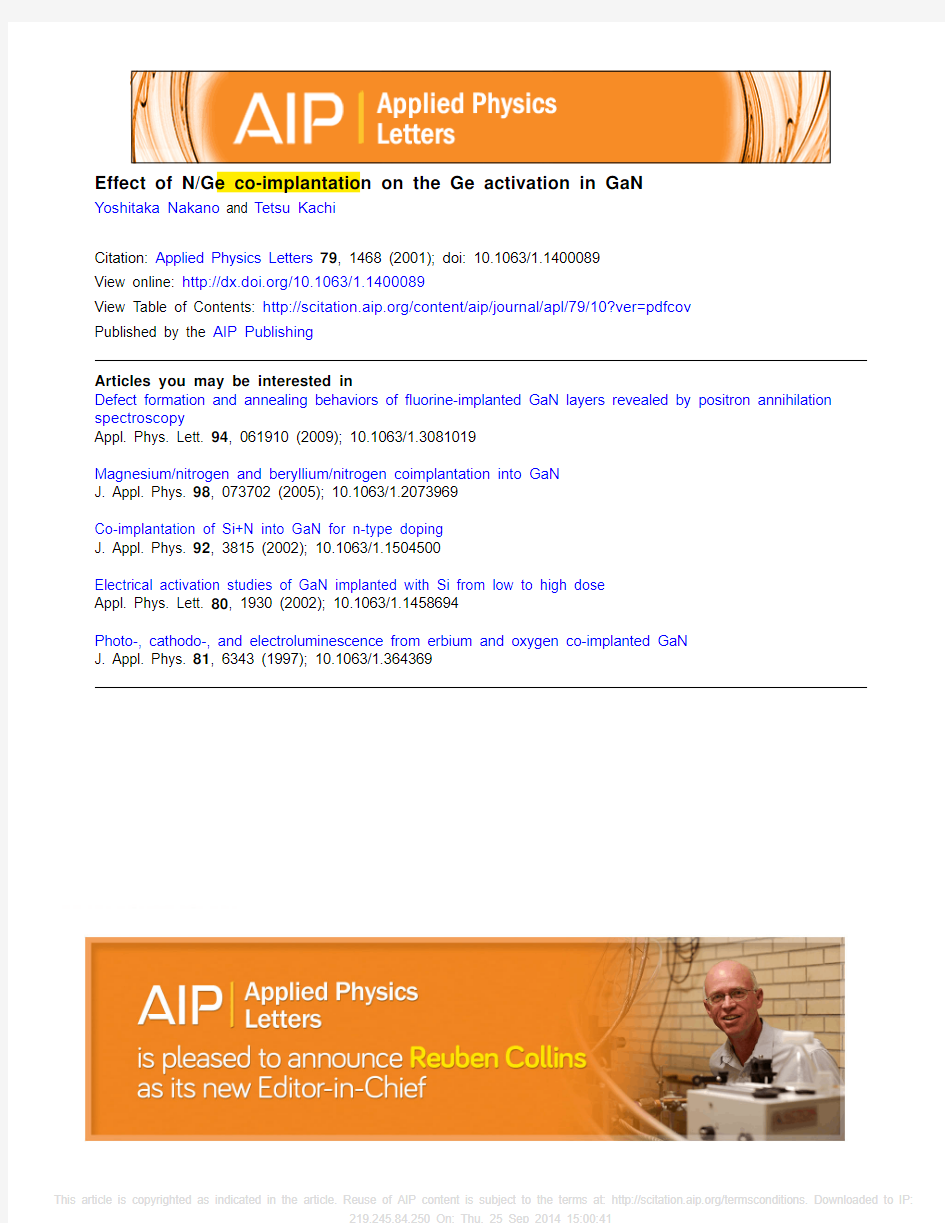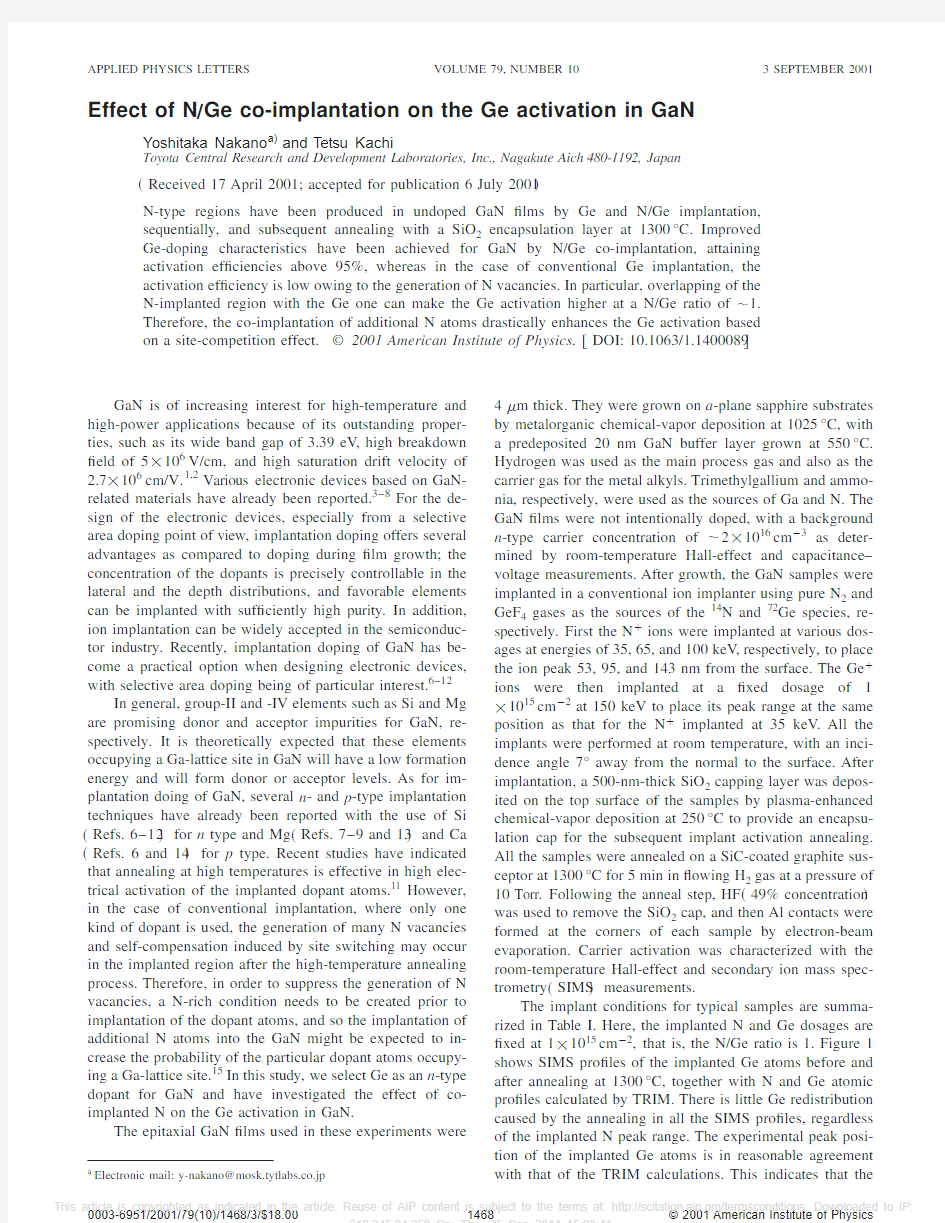Effect of N Ge co-implantation on the Ge activation in GaN


Effect of N/Ge co-implantation on the Ge activation in GaN
Yoshitaka Nakano and Tetsu Kachi
Citation: Applied Physics Letters 79, 1468 (2001); doi: 10.1063/1.1400089
View online: https://www.360docs.net/doc/5b4312961.html,/10.1063/1.1400089
View Table of Contents: https://www.360docs.net/doc/5b4312961.html,/content/aip/journal/apl/79/10?ver=pdfcov
Published by the AIP Publishing
Articles you may be interested in
Defect formation and annealing behaviors of fluorine-implanted GaN layers revealed by positron annihilation
spectroscopy
Appl. Phys. Lett. 94, 061910 (2009); 10.1063/1.3081019
Magnesium/nitrogen and beryllium/nitrogen coimplantation into GaN
J. Appl. Phys. 98, 073702 (2005); 10.1063/1.2073969
Co-implantation of Si+N into GaN for n-type doping
J. Appl. Phys. 92, 3815 (2002); 10.1063/1.1504500
Electrical activation studies of GaN implanted with Si from low to high dose
Appl. Phys. Lett. 80, 1930 (2002); 10.1063/1.1458694
Photo-, cathodo-, and electroluminescence from erbium and oxygen co-implanted GaN
J. Appl. Phys. 81, 6343 (1997); 10.1063/1.364369
This article is copyrighted as indicated in the article. Reuse of AIP content is subject to the terms at: https://www.360docs.net/doc/5b4312961.html,/termsconditions. Downloaded to IP:
219.245.84.250 On: Thu, 25 Sep 2014 15:00:41
Effect of N ?Ge co-implantation on the Ge activation in GaN
Yoshitaka Nakano a)and Tetsu Kachi
Toyota Central Research and Development Laboratories,Inc.,Nagakute Aich 480-1192,Japan
?Received 17April 2001;accepted for publication 6July 2001?
N-type regions have been produced in undoped GaN ?lms by Ge and N/Ge implantation,sequentially,and subsequent annealing with a SiO 2encapsulation layer at 1300°C.Improved Ge-doping characteristics have been achieved for GaN by N/Ge co-implantation,attaining activation ef?ciencies above 95%,whereas in the case of conventional Ge implantation,the activation ef?ciency is low owing to the generation of N vacancies.In particular,overlapping of the N-implanted region with the Ge one can make the Ge activation higher at a N/Ge ratio of ?1.Therefore,the co-implantation of additional N atoms drastically enhances the Ge activation based on a site-competition effect.?2001American Institute of Physics.?DOI:10.1063/1.1400089?
GaN is of increasing interest for high-temperature and high-power applications because of its outstanding proper-ties,such as its wide band gap of 3.39eV ,high breakdown ?eld of 5?106V/cm,and high saturation drift velocity of 2.7?106cm/V.1,2Various electronic devices based on GaN-related materials have already been reported.3–8For the de-sign of the electronic devices,especially from a selective area doping point of view,implantation doping offers several advantages as compared to doping during ?lm growth;the concentration of the dopants is precisely controllable in the lateral and the depth distributions,and favorable elements can be implanted with suf?ciently high purity.In addition,ion implantation can be widely accepted in the semiconduc-tor industry.Recently,implantation doping of GaN has be-come a practical option when designing electronic devices,with selective area doping being of particular interest.6–12
In general,group-II and -IV elements such as Si and Mg are promising donor and acceptor impurities for GaN,re-spectively.It is theoretically expected that these elements occupying a Ga-lattice site in GaN will have a low formation energy and will form donor or acceptor levels.As for im-plantation doing of GaN,several n -and p -type implantation techniques have already been reported with the use of Si ?Refs.6–12?for n type and Mg ?Refs.7–9and 13?and Ca ?Refs.6and 14?for p type.Recent studies have indicated that annealing at high temperatures is effective in high elec-trical activation of the implanted dopant atoms.11However,in the case of conventional implantation,where only one kind of dopant is used,the generation of many N vacancies and self-compensation induced by site switching may occur in the implanted region after the high-temperature annealing process.Therefore,in order to suppress the generation of N vacancies,a N-rich condition needs to be created prior to implantation of the dopant atoms,and so the implantation of additional N atoms into the GaN might be expected to in-crease the probability of the particular dopant atoms occupy-ing a Ga-lattice site.15In this study,we select Ge as an n -type dopant for GaN and have investigated the effect of co-implanted N on the Ge activation in GaN.
The epitaxial GaN ?lms used in these experiments were
4?m thick.They were grown on a -plane sapphire substrates by metalorganic chemical-vapor deposition at 1025°C,with a predeposited 20nm GaN buffer layer grown at 550°C.Hydrogen was used as the main process gas and also as the carrier gas for the metal alkyls.Trimethylgallium and ammo-nia,respectively,were used as the sources of Ga and N.The GaN ?lms were not intentionally doped,with a background n -type carrier concentration of ?2?1016cm ?3as deter-mined by room-temperature Hall-effect and capacitance–voltage measurements.After growth,the GaN samples were implanted in a conventional ion implanter using pure N 2and GeF 4gases as the sources of the 14N and 72Ge species,re-spectively.First the N ?ions were implanted at various dos-ages at energies of 35,65,and 100keV ,respectively,to place the ion peak 53,95,and 143nm from the surface.The Ge ?ions were then implanted at a ?xed dosage of 1?1015cm ?2at 150keV to place its peak range at the same position as that for the N ?implanted at 35keV .All the implants were performed at room temperature,with an inci-dence angle 7°away from the normal to the surface.After implantation,a 500-nm-thick SiO 2capping layer was depos-ited on the top surface of the samples by plasma-enhanced chemical-vapor deposition at 250°C to provide an encapsu-lation cap for the subsequent implant activation annealing.All the samples were annealed on a SiC-coated graphite sus-ceptor at 1300°C for 5min in ?owing H 2gas at a pressure of 10Torr.Following the anneal step,HF ?49%concentration ?was used to remove the SiO 2cap,and then Al contacts were formed at the corners of each sample by electron-beam evaporation.Carrier activation was characterized with the room-temperature Hall-effect and secondary ion mass spec-trometry ?SIMS ?measurements.
The implant conditions for typical samples are summa-rized in Table I.Here,the implanted N and Ge dosages are ?xed at 1?1015cm ?2,that is,the N/Ge ratio is 1.Figure 1shows SIMS pro?les of the implanted Ge atoms before and after annealing at 1300°C,together with N and Ge atomic pro?les calculated by TRIM.There is little Ge redistribution caused by the annealing in all the SIMS pro?les,regardless of the implanted N peak range.The experimental peak posi-tion of the implanted Ge atoms is in reasonable agreement with that of the TRIM calculations.This indicates that the
a ?
Electronic mail:y-nakano@mosk.tytlabs.co.jp
APPLIED PHYSICS LETTERS VOLUME 79,NUMBER 103SEPTEMBER 2001
14680003-6951/2001/79(10)/1468/3/$18.00?2001American Institute of Physics
This article is copyrighted as indicated in the article. Reuse of AIP content is subject to the terms at: https://www.360docs.net/doc/5b4312961.html,/termsconditions. Downloaded to IP:
219.245.84.250 On: Thu, 25 Sep 2014 15:00:41
implanted Ge atoms are stable in GaN even at very high
processing temperatures.This result suggests that long-range diffusion of the implanted Ge atoms cannot occur after an-nealing at 1300°C,because of the Ge atoms being strongly bonded to the lattice.Therefore,diffusion of Ge into GaN from an external source is not practical and ion implantation is the only possibility to introduce Ge into GaN for selective area doping.
The dependence of the Ge activation on the depth distri-bution of the co-implanted N atoms was investigated.As-suming that the sheet carrier concentration n s determined by Hall-effect measurements re?ects the number of carriers gen-erated from within a full width at half maximum ?FWHM ?region of the depth distribution of the implanted Ge atoms,Ge activation ef?ciencies (n s /n Ge ?100)for samples 1–4can be estimated,as shown in Table I.Here,n Ge is the total number of Ge atoms within the FWHM region of the SIMS pro?les.The sheet carrier concentration is found to strongly depend on the implanted N peak range relative to the Ge peak one.That is,the Ge activation ef?ciency drastically increases with closely overlapping for the N peak range with the Ge peak one,as shown in Figs.1?b ?,1?c ?,and 1?d ?.In particular,Ge activation ef?ciencies above 95%can be achieved for sample 2,in which the N peak range is equiva-lently placed at the Ge peak one.On the other hand,an
increase in sheet carrier concentration is also seen for the conventional Ge-implanted sample ?sample 1?,which may be related to the generation of N vacancies.That is,there are insuf?cient N atoms to maintain the GaN stoichiometry in the Ge-implanted region.Considering that the N vacancies act as a donor level,many carriers can be generated from these N vacancies in the Ge-implanted region for sample 1.So,the conventional Ge implantation seems to suppress the Ge activation.Probably,the Ge activation ef?ciency is roughly estimated to be as low as 40%for sample 1,consid-ering the increase in carrier concentration caused by the gen-eration of many N vacancies.Therefore,the co-implantation of additional N atoms is considered to drastically enhance the Ge activation.So,our proposed co-implantation with N and dopant atoms can be extremely effective in increasing electrical activation of the dopant.
Moreover,the N/Ge ratio dependence of the Ge activa-tion was investigated in the N/Ge co-implantation process.Here,the dosage of the implanted Ge atoms is ?xed at 1?1015cm ?2,and the implanted N peak range is also ?xed to be equivalently placed at the Ge peak one,as shown in Fig.1?b ?.Figure 2shows room-temperature sheet carrier concen-trations and mobilities as a function of N/Ge ratio for the N/Ge co-implanted samples.The Ge activation can be clas-si?ed into three regions in view of GaN stoichiometry;?a ?N/Ge ?0.1,?b ?0.3?N/Ge ?3,and ?c ?N/Ge ?10.In region ?a ?,there are extremely insuf?cient N atoms available to maintain the stoichiometry of GaN.Although the sheet car-rier concentration is relatively high,the Ge activation is too poor owing to the generation of many N vacancies,as typi-cally indicated for the conventional Ge-implanted sample ?sample 1?.In region ?b ?,the sheet carrier concentration is kept high with a relative high electron mobility of ?50cm 2/Vs even at a Ge dosage of 1?1015cm ?2.The Ge acti-vation ef?ciencies are above 95%under these optimum N/Ge ratio conditions.In region ?c ?,the sheet carrier concen-tration increases and the mobility drastically decreases under N-excess conditions,which may be typical characteristics of the implantation damage caused by the increase in the total ion mass of the implanted atoms.Therefore,the optimum N/Ge ratio is found to be ?1for the high Ge activation.
In summary,we have demonstrated that the co-implantation with N and Ge atoms into GaN drastically en-hances the Ge activation based on a site-competition effect.In particular,overlapping of the N-implanted region with
the FIG.1.TRIM-simulated atomic pro?les of implanted N ?dashed line ?and
Ge ?solid line ?and SIMS pro?les of Ge implanted in GaN,as implanted ???and annealed ???at 1300°C for samples
1–4.
FIG.2.Dependence of sheet carrier concentration ???and mobility ???upon the N/Ge ratio for N/Ge co-implanted GaN samples.
TABLE I.Implant conditions and sample characteristics.
Sample N implant 1?1015cm ?2
?keV ?
Ge implant 1?1015cm ?2
?keV ?
Sheet carrier concentration (1014cm ?2)
Ge activation
?%?
1None 150 3.3082a 235150 4.4398365150 2.89644
100
150
2.64
60
These data contain many carriers generated by N vacancies.
This article is copyrighted as indicated in the article. Reuse of AIP content is subject to the terms at: https://www.360docs.net/doc/5b4312961.html,/termsconditions. Downloaded to IP:219.245.84.250 On: Thu, 25 Sep 2014 15:00:41
Ge one makes the Ge activation higher.The N/Ge co-implantation can achieve Ge activation ef?ciencies above 95%at the optimum N/Ge ratio of?1,whereas the conven-tional Ge implantation seems to suppress the Ge activation owing to the generation of N vacancies.
The authors gratefully acknowledge useful technical dis-cussions with Professor T.Jimbo at the Nagoya Institute of Technology.
1H.Morkoc,S.Strite,G.B.Gao,M.E.Lin,B.Sverdlov,and M.Burns,J. Appl.Phys.76,1363?1994?.
2T.P.Chow and R.Tyagi,IEEE Trans.Electron Devices41,1481?1994?. 3M.Asif Khan,J.N.Kuznia,A.R.Bhattarai,and D.T.Olson,Appl.Phys. Lett.62,1786?1993?.
4S.C.Binari,L.B.Rowland,W.Kruppa,G.Kelner,K.Doverspike,and D. K.Gaskill,Electron.Lett.30,1248?1994?.
5M.Asif Khan,A.Bhattarai,J.N.Kuznia,and D.T.Olson,Appl.Phys. Lett.63,1214?1993?.
6J.C.Zolper,R.J.Shul,A.G.Baca,R.G.Wilson,S.J.Pearton,and R.A. Stall,Appl.Phys.Lett.68,2273?1996?.
7A.P.Zhang,J.W.Johnson,F.Ren,J.Han,A.Y.Polyakov,N.B.Smirnov, https://www.360docs.net/doc/5b4312961.html,orkov,J.M.Redwing,K.P.Lee,and S.J.Pearton,Appl.Phys. Lett.78,823?2001?.
8A.P.Zhang,G.Dang,F.Ren,J.Han,A.Y.Polyakov,N.B.Smirnov,A. https://www.360docs.net/doc/5b4312961.html,orkov,J.M.Redwing,H.Cho,and S.J.Pearton,Appl.Phys.Lett. 76,3816?2000?.
9S.J.Pearton,C.B.Vartuli,J.C.Zolper,C.Yuan,and R.A.Stall,Appl. Phys.Lett.67,1435?1995?.
10J.C.Zolper,H.H.Tan,J.S.Williams,J.Zou,D.J.H.Cockayne,S.J. Pearton,M.Hagerott Crawford,and R.F.Karlicek,Jr.,Appl.Phys.Lett. 70,2729?1997?.
11X.A.Cao,C.R.Abernathy,R.K.Singh,S.J.Pearton,M.Fu,V.Sarve-palli,J.A.Sekhar,J.C.Zolper,D.J.Rieger,J.Han,T.J.Drummond,R. J.Shul,and R.G.Wilson,Appl.Phys.Lett.73,229?1998?.
12C.J.Eiting,P.A.Grudowski,R.D.Dupuis,H.Hsia,Z.Tang,D.Becher, H.Kuo,G.E.Stillman,and M.Feng,Appl.Phys.Lett.73,3875?1998?. 13J.S.Chan,N.W.Cheung,L.Schloss,E.Jones,W.S.Wong,N.Newman, X.Liu,E.R.Weber,A.Gassman,and M.D.Rubin,Appl.Phys.Lett.68, 2702?1996?.
14J.C.Zolper,R.G.Wilson,S.J.Pearton,and R.A.Stall,Appl.Phys.Lett. 68,1945?1996?.
15H.Kobayashi and W.H.Gibson,Appl.Phys.Lett.74,2355?1999?.
This article is copyrighted as indicated in the article. Reuse of AIP content is subject to the terms at: https://www.360docs.net/doc/5b4312961.html,/termsconditions. Downloaded to IP:
219.245.84.250 On: Thu, 25 Sep 2014 15:00:41
